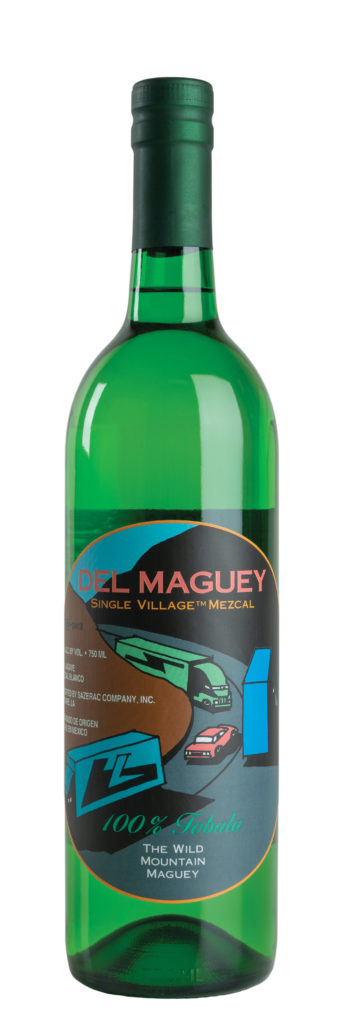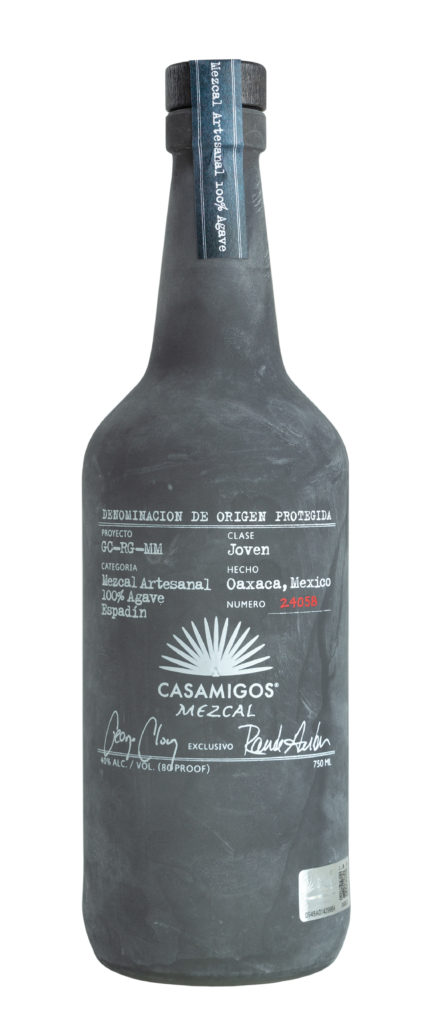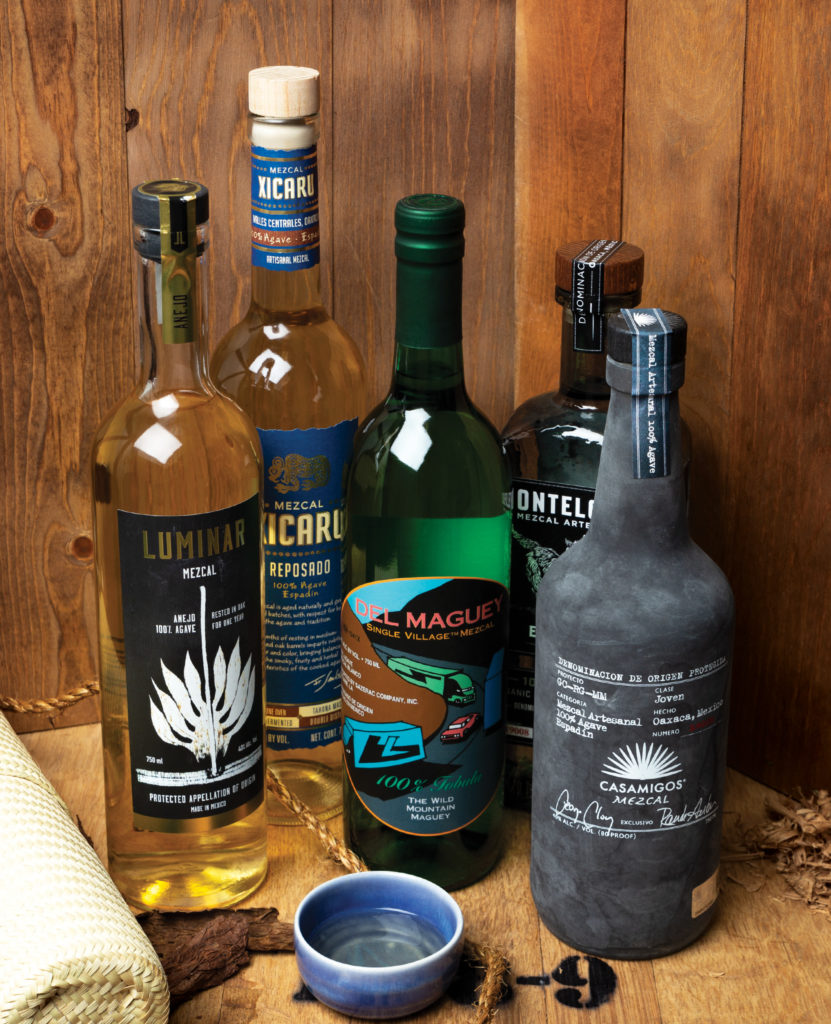“Mezcal” refers to both the broad category of Mexican spirit made from the agave plant (which includes tequila) and a sub-type also called mezcal. In this 5 to Try I will either clear up the confusion or get you to a state where you don’t care what you’re drinking as long as it’s good!
By Erik Calviño
1 Del Maguey Single Village Mezcal – Tobala
Oaxaca
45% Alc. by Vol.
Agave Tobalá

A mezcal by any other name
According to the internationally recognized Appellation of Origin, mezcal is the umbrella category for all Mexican distilled spirits made from the agave plant, also known as the maguey [pronounced mah-GAY]. Tequila, which is by far the most popular and commercially available subcategory of mezcal, is made exclusively from the blue agave varietal and must come from one of five Mexican states, the most prominent of which is Jalisco, where the city of Tequila is located. That’s what it takes for a spirit to be labeled tequila. It’s the main character in many a sappy country song, lovestruck poem, battle cry, and slurred wedding speech. But this isn’t a tequila story; we’re here to drink mezcal, as in the subcategory of mezcal. I know you’re still confused but we’re about to turn that corner of mezcal enlightenment. Stay with me.
For a spirit to be legally labeled mezcal, it can be distilled from any agave varietal — as opposed to just blue agave — and it has to come from one of nine Mexican states. The overwhelming majority of mezcal is produced in Oaxaca [pronounced wa-HA-kah].
Perhaps the most important difference between tequila and mezcal is in the way that it is made. For tequila, the majority of producers take the harvested blue agave hearts or piñas and stuff them into autoclaves (high pressure steam ovens) or kilns where they are cooked to convert the plant’s fibrous starches into sugars over a few hours. For mezcal, on the other hand, the process is typically more artisanal and labor intensive. Every producer has their own family method and technique, but generally speaking, the halved agave hearts are roasted in stone-lined earthen pits using aromatic firewood as the heat source. This pile of hot, smoking agave hearts is covered with a combination of tarps and earth to prevent the smoke from escaping. The hearts are then smoked for several days with the goal of not only converting starch to sugar, but also to impart a smoky characteristic to the cooked agave. This smokiness adds a complexity of flavor and aroma to the final product that is one of the most significant and distinguishable flavor differences between the sister spirits. And for our purposes, that smokiness makes mezcal a more suitable pairing partner for cigars!
Variety is the spice of life
As is the case with most if not all agricultural luxury products, selecting the plant varietal for the product dictates the yield, flavor and aroma characteristics, processing difficulty, and eventually the product’s price. In the world of mezcals, Espadín agave [pronounced es-pa-DEEN] is the most widely planted and highest yielding and, as a result, the most commonly used agave varietal in mezcal. Wild agaves, like the Tobalá [pronounced toba-lah] employed in the Del Maguey Single Village Mezcal Tobala (delmaguey.com) have yields so low that it takes eight Tobalá hearts to match the yield of one Espadín heart. But the flavor it produces in this superbly executed mezcal is decidedly singular.
Tasting Notes
The nose on the Del Maguey Single Village Mezcal Tobala is world-class, with a combination of caramel, fruit, chlorophyll, wood, and peat smoke. The flavors are impeccably balanced. They are at once intense and delicate with a profile of mango, green apple, baker’s spice, and a bit of mint with a beautifully long, resinous finish.
Pairing Notes
I paired this mezcal with a Padrón Anniversary Series 1964 because once I tasted them together there was no choice; every sip of the mezcal that was followed by the Padrón resulted in a dessert-like blast of cocoa powder from the cigar that was simply sublime. In exchange, the cigar seemed to intensify the green apple and mango flavors in the mezcal, bringing them to the forefront in an undeniably delicious way. It’s hard to imagine a better pairing of a cigar and spirit.

2 Mezcal Xicaru Reposado
Oaxaca
40% Alc. by Vol.
Agave Espadín

Industrial vs Artisanal
While tequila’s global popularity was growing, its artisanal roots quickly gave way to the corporate world of machine-driven industrial processes and economies of scale. That’s not to say that there aren’t any artisanal tequilas in the marketplace. There most certainly are, but the majority of tequila on the shelves and in your cocktails is of the industrial variety. Conversely, in the world of mezcal, the overwhelming majority of producers are still artisanal. In other words, they’re still cooking the agave hearts over multiple days in earthen pits, still crushing the cooked agave using the painstakingly slow horse-drawn tahona wheel, and still distilling in small batches. It’s not uncommon to find the batch number or bottle number handwritten on bottles, not as a marketing gimmick but as a simple way of keeping track of their bottles.
While tequila was out conquering the world, the tiny mezcal operations or palenques in these rural villages kept producing mezcal in the most traditional way. The methods and techniques being used, which are passed down from generation to generation, typically have the singular goal of making the best mezcal that they can possibly make. And by “best” I mean what that maestro mezcalero considers to be the best. After all, that is what he and his village neighbors will all be drinking. These rural villages don’t have a Total Wine & More; they’re drinking what the local palenque produces.
The beauty of it is that you can sit in a bar on Main Street USA and drink an artisanal mezcal like Xicaru Reposado, which was produced under the watchful eye of master mezcalero Fernando Santibañez, and taste the results of his generations-old family method. It is a very real experience. It is quite a different thing than tasting a product that was pumped out in industrial quantities through a network of pipes and tanks and automated bottling lines in order to meet a certain figure.
To age or not to age
In the most traditional sense, mezcal is enjoyed young or joven, bottled right out of the distillation process. The young version of the spirit is fresh, vibrant, and alive. Like smoking a cigar right off the rolling table, there are cigars that I like so much that I will just about chain smoke them when I am at the factory, but in turn would never pick up from a walk-in humidor in the States. I feel the same about some young mezcals.
Then there are the mezcals that really benefit from a little time in the barrel. For the sake of clarification, a mezcal that is reposado or rested is the same exact product that went into the bottle joven. It’s just that a certain amount of it was bottled as joven and a certain amount was pumped into barrels for aging. According to the regulations governing mezcal, you can label your mezcal reposado if it has aged in a barrel for at least two months. If you leave it in the barrel for at least twelve months, you can label your product añejo or aged. In both cases, reposado and añejo, the producer is generally looking to gain flavor and aroma characteristics from the barrel and in some cases they want time to smooth out hard edges.
Tasting Notes
The Mezcal Xicaru Reposado is a perfect example of a mezcal that gained another dimension in the barrel. Just nosing it for a moment tells you everything you need to know; there are notes of vanilla and oak blended with that vegetal, green aroma of a traditional mezcal. On the palate the Xicaru is creamy and balanced with subtle vanilla over a base of spice, smoke, minerality, and grass.
Pairing Notes
The Herrera Esteli Norteño on its own is all about cocoa, earth, and a touch of pepper. If you have an advanced palate you can pick up even more flavors and aromas or you can take a sip of Xicaru Reposado and let it show you the way. After a sip, the cigar’s previously subtle toasted almond cranks up, baker’s spices show up, and the cocoa turns into full-on milk chocolate. All of this while the mezcal’s vanilla and honey take a forceful step to the forefront.

3 Casamigos Mezcal Joven
Oaxaca
40% Alc. by Vol.
Agave Espadín

Big Boys Going All In
The growth in popularity for mezcal in recent years hasn’t gone unnoticed as some of the biggest names in the liquor business continue to make significant mezcal investments. According to International Wine & Spirits Research, US volume of mezcal sales grew 279% in the years between 2005 and 2015. This growth spurred the world’s largest independent spirits producer, Bacardi, to enter into a distribution agreement with Casa AGP, makers of Zignum Mezcal, Mezcal El Recuerdo de Oaxaca, and Mezcal El Señorio in 2013. At the time, the move made Bacardi the first global spirits company to have a complete mezcal portfolio. The investment floodgates opened soon after and players like William Grant & Sons, Diageo, and Proximo Spirits all joined the party. In mid-2017 global wine and spirits giant Pernod-Ricard announced that they would be taking a majority stake in Del Maguey Single Village Mezcal, one of the leading premium, artisanal mezcal producers. A month later news and social media networks were abuzz with the announcement of Diageo’s acquisition of Casamigos in a deal that could be worth up to $1 billion. Casamigos, of course, is known for being George Clooney, Rande Gerber, and Mike Meldman’s little tequila project turned global sensation. In 2018, well after the Diageo acquisition, the company added their first mezcal to the portfolio, a joven mezcal made of 100 percent Espadín agave in Oaxaca.
Under The Volcano
George Clooney’s attraction to agave spirits isn’t the first time that mezcal and tequila have had their brush with stardom. In fact, Under The Volcano — Malcolm Lowry’s mezcal-soaked masterpiece about the utterly self-destructive final hours of a British consul living in Cuernavaca, Mexico — inspired the 1984 adaptation directed by John Huston (The Maltese Falcon, The Treasure of the Sierra Madre, and Moby Dick among others). The story depicts the tragic and inescapable demise of Geoffrey Firmin, played by Academy Award nominated Albert Finney (Big Fish, The Gathering Storm, and Erin Brockovich) in the film, on the day that his estranged wife returns to rekindle their relationship alongside Geoffrey’s younger half-brother. Spoiler alert: it all goes spectacularly sideways in ways that are sad, predictable, at times comical, but as is the case in all tragedies, absolutely inevitable. The prose is swollen with Faustian and biblical symbolism as well as numerology but all of it with so much drinking that I struggle to think of any other book that even comes close in that regard. Throughout the story, mezcal plays such a profound role that some have argued that the book has at least in small part been responsible for the spirit’s recent surge in popularity.
Tasting Notes
Casamigos Mezcal Joven is very much a beginner’s mezcal in that everything it has is toned down one or two clicks. So while it is unbelievably smooth and easy to drink, it lacks the intensity of flavor and smokiness that some seek in a mezcal joven. The flavors and aromas that it does have are extremely pleasant. On the nose you will find vegetal, fruit, and mineral notes while on the palate there are flavors of vanilla, lemon, subtle pepper, and sweet agave.
Pairing Notes
The Balmoral Añejo XO Connecticut delivers a mild to medium strength profile of wood, pepper, coffee, cream, and subtle nuts before the mezcal is introduced. Take a sip of the Casamigos and let it coat your palate before you swallow it. On subsequent puffs you’ll notice the pepper and wood from the cigar dive deep into the background while the vanilla and nut become much more prominent than before.

4 Montelobos Mezcal Artesanal Espadín
Oaxaca
43.2% Alc. by Vol.
Agave Espadín

Horse-Drawn Mashing
No artisanal process would be complete without incorporating a horse-drawn something right? That’s where the tahona [pronounced ta-OWN-a] comes in. The tahona is a horse-drawn circular mill where a horse or donkey walks in circles around the mill rolling a wheel-like stone that mashes and pulverizes the cooked agave chunks. The process is not unlike the old-time way of making cider if you’ve ever seen that, except that instead of apples, we’re mashing agave to extract the sugars that were produced during the roasting process. It is the job of the mezcaleros to constantly rearrange the agave chunks to ensure maximum extraction. Using a pitchfork, the mezcaleros transport the mashed agave fibers into open fermentation tanks where they add spring water and allow the wild yeast to begin the fermentation process.
In an industrial operation, this process is handled by machinery. The chopped agave chunks are fed onto a conveyor belt where it chops and mashes it before dumping it straight into a fermentation tank where they introduce a consistent and stable yeast strain. The process is extremely efficient; the downside from a romantic standpoint is that you lose the cultural and human element of the mezcal making process. From a practical standpoint, the industrial operation is seldom able to get the maximum extraction from the agave, which in turn affects flavor. Finally, from a sustainability perspective, industrial mezcal operations with their high-speed and high-efficiency processes present a risk of out-producing the supply of agave.
Hangover? What Hangover?
One of the biggest selling points for many artisanal mezcal enthusiasts is the clean nature of the spirit. The lack of impurities and chemicals in an artisanal mezcal make that next-day hangover a lot less likely than with many brown spirits. For example, in producing this 5 to Try section I probably consumed enough mezcal to kill the horse that was pushing the stone wheel in the tahona! And while I did have to Uber home from the office a couple of nights, not once did I feel the ill effects on the following day. Is this a good thing? I don’t know; without the deterrent of a terrible morning hanging over my head I may be more inclined to go the way of Geoffrey Firmin in Under The Volcano. If you don’t get the reference, read the book or at least watch the movie. Suffice it to say it isn’t a good ending.
Tasting Notes
The Montelobos Mezcal Artesanal Espadín Joven is beautifully fragrant in the glass; there are prominent notes of cucumber, fruit, spice, and a hint of caramel in the background. In the mouth the mezcal is well balanced between sweet and hot characteristics. There are flavors of smoke, green agave, black pepper, minerality, and a touch of sugar cane sweetness.
Pairing Notes
If there was such a thing as a “cream bomb” of a pairing, this would most certainly be it. The cigar’s smooth, silky textured smoke makes the mezcal feel twice as viscous as it does on its own. And the heat from the mezcal, which is not too high to begin with, lends the cigar a kick that you didn’t know it was missing. Notes of pepper, nut, and leather jump to the forefront of the cigar with every sip while the Montelobos takes on a creamy caramel up front that had been lingering almost imperceptibly in the background. A perfectly complementary pairing.

5 Luminar Mezcal Añejo
Zacatecas
40% Alc. by Vol.
Agave: A. Tequilana

What, No Worm?
I know you’ve been thinking about it. You’ve been thinking, “When is he going to address the elephant in the room, or rather the worm in the bottle?” So there’s plenty on the subject of the worm. I’ve spoken to some Oaxaqueños who swear that you can’t get the full taste of the mezcal without eating the worm while most others claim that the worm was a marketing ploy devised in the 1950s to take advantage of young Americans’ one-upmanship. The problem is that the mezcal with a worm in it is usually of a terribly low quality. So the brave American tourist would endure the shot of bad mezcal, eat the worm, squirm and gag, and everyone would have a good laugh. And, in a sense, it worked as a marketing gimmick; to this day people still associate mezcal with the creepy little gusano floating around in a bottle.
But since 2005, when the Mexican government began certifying mezcal for sale and export, the premium artisanal mezcals that have been making their way around the world have no worm in them. And I for one think it won’t be long until the old worm in the bottle trick is relegated strictly to tourist tchotchke status.
One final note on the worm; the gusano is commonly eaten in Mexico in various forms. You can have them fried, toasted, raw, or pickled on just about any street corner in Mexico. That is real and NOT a gimmick. The other thing that is not a gimmick and an excellent accompaniment to a good mezcal is sal de gusano or worm salt. In Oaxaca it is normal to be served a glass of mezcal accompanied by orange wedges covered in worm salt. How the salt is made varies from brand to brand but generally speaking it is composed of chilies, worms, and sea salt; unlike the lime and salt chaser used to mask the bite of tequila, the flavors of the orange and worm salt are meant to complement the mezcal’s fresh, smoky sweet flavors.
Tasting Notes
The Luminar Mezcal Añejo presents itself with a translucent straw color in the bottle. There is little in the way of information coming from the label except the age, ABV, place of origin, and agave varietal. You may think, “What more do you want?” I like to know a little more about the processes employed in producing it as well as the maestro mezcalero who made it happen. On the nose this mezcal delivers notes of caramel and light spice. The palate has caramel, honey, and only a touch of heat but zero smokiness. The flavor is more reminiscent of an aged tequila than a mezcal.
Pairing Notes
This pairing brought out the best in both products. The mezcal’s caramel and vanilla were ramped up to dessert-like levels, which were balanced by the cigar’s earth and pepper core. The Espinosa Habano’s pepper zing coming from the filler was significantly toned down by the spirit allowing the wrapper’s creamy, leather character to show through.





